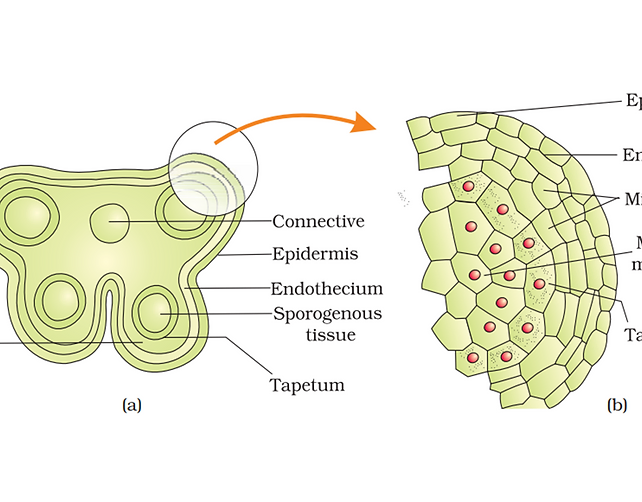MCQ ON Microsporogenesis for NEET |MCQ ON Microsporogenesis for NEET Biology class 12th |MCQ Questions for class 12 Biology chapter 2, Microsporogenesis with answer | Check the below NCERT MCQ question for class 12 Biology chapter 2 based on Microsporogenesis with answers.
MCQ Questions for class 12 Biology with Answers were prepared based on the latest pattern. We have provided class 12 Biology MCQ questions on Microsporogenesis with answers to help students understand the concept very well.

Microsporogenesis
MCQ on is useful for NEET/ CSIR/ UGC/ CBSE/ ICSE /AIIMS EXAM/ AFMC EXAM/ JAC exam/ STATE LEVEL MEDICAL EXAM
Introduction:-
Microsporogenesis:– Microsporogenesis is the process by which microspore mother cells (also known as microsporocytes) within the anther of a flowering plant undergo meiosis to produce microspores. Microsporogenesis is a crucial step in the development of male gametophytes (pollen grains) in plants, which are essential for sexual reproduction.
The key steps in microsporogenesis are as follows:
1. Microspore Mother Cell Formation: Within the pollen sacs of the anther, diploid microspore mother cells are formed.
2. Meiosis: Each microspore mother cell undergoes meiosis, a type of cell division that reduces the chromosome number by half. This results in the formation of four haploid microspores from each microspore mother cell.
3. Microspore Release: The microspores are released from the microspore mother cells as a result of the anther’s dehiscence (splitting open) or other mechanisms.
4. Microspore Development: Each haploid microspore then undergoes further development, including mitotic divisions and differentiation, to ultimately form a mature pollen grain.
These mature pollen grains contain the male gametophytes, which are responsible for fertilizing the female reproductive structures (usually the ovule) of the same or another flower, leading to the formation of seeds. Microsporogenesis is a vital part of the plant’s reproductive cycle and ensures the production of genetically diverse offspring through sexual reproduction.
MCQ ON Microsporogenesis for NEET
Here are 15 multiple-choice questions (MCQs) related to microsporogenesis (the process of microspore formation) in plants, along with their answers:
1. What is microsporogenesis in plants?
a) Formation of megaspores
b) Formation of microspores
c) Fertilization of seeds
d) Pollination of flowers
Answer: b) Formation of microspores
2. In which part of the plant does microsporogenesis occur?
a) Anther
b) Ovary
c) Petal
d) Stem
Answer: a) Anther
3. Microsporogenesis is a crucial step in the production of:
a) Leaves
b) Fruits
c) Pollen grains
d) Roots
Answer: c) Pollen grains
4. What is the ploidy level of microspore mother cells (MMC) before undergoing microsporogenesis?
a) Haploid (n)
b) Diploid (2n)
c) Tetraploid (4n)
d) Triploid (3n)
Answer: b) Diploid (2n)
5. During microsporogenesis, the MMC undergoes meiosis to produce:
a) Microspores
b) Megaspores
c) Embryos
d) Roots
Answer: a) Microspores
6. Microsporogenesis leads to the formation of ___ microspores from a single MMC.
a) One
b) Two
c) Four
d) Eight
Answer: c) Four
7. The microspores produced during microsporogenesis are ___ in nature.
a) Diploid (2n)
b) Haploid (n)
c) Triploid (3n)
d) Tetraploid (4n)
Answer: b) Haploid (n)
8. After microsporogenesis, what process transforms haploid microspores into mature pollen grains?
a) Germination
b) Photosynthesis
c) Fertilization
d) Pollination
Answer: a) Germination
9. What is the role of pollen grains in plant reproduction?
a) Attracting pollinators
b) Storing nutrients
c) Producing seeds
d) Fertilizing ovules
Answer: d) Fertilizing ovules
10. In which plant organ is microsporogenesis essential for sexual reproduction?
a) Leaves
b) Stem
c) Roots
d) Flowers
Answer: d) Flowers
11. During microsporogenesis, what is the chromosome number in the resulting microspores?
a) Diploid (2n)
b) Haploid (n)
c) Triploid (3n)
d) Tetraploid (4n)
Answer: b) Haploid (n)
12. What is the final outcome of microsporogenesis?
a) Formation of eggs
b) Production of fruit
c) Development of seedlings
d) Generation of pollen grains
Answer: d) Generation of pollen grains
13. Which of the following is NOT a product of microsporogenesis?
a) Microspores
b) Pollen grains
c) Ovules
d) Megaspores
Answer: c) Ovules
14. The process of microsporogenesis is crucial for the ___ of flowering plants.
a) Vegetative growth
b) Asexual reproduction
c) Sexual reproduction
d) Formation of leaves
Answer: c) Sexual reproduction
15. Where do microspores ultimately end up within a flower?
a) In the ovary
b) On the stigma
c) In the anther
d) In the petal
Answer: c) In the anther
Conclusion:-
MCQ ON Microsporogenesis for NEET | The process of microsporogenesis is crucial for the ___ of flowering plants. a) Vegetative growth, b) Asexual reproduction c) Sexual reproduction, d) Formation of leaves, Answer: c) Sexual reproduction







Leave a Comment